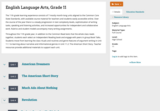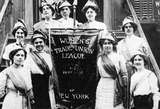
Learn how to identify the main ideas and supporting details in an informational text by using a list of guiding questions.
- Subject:
- Arts
- English Language Arts
- Material Type:
- Reading
- Provider:
- Annenberg Learner
- Date Added:
- 05/05/2022

Learn how to identify the main ideas and supporting details in an informational text by using a list of guiding questions.

In this lesson for early readers, students will describe the major events in the plot, describe the characters, and ask and answer questions about the first chapter in Frog and Toad Are Friends---Spring.

This lesson uses the book Explorers of North America - A True Book by Brendan January to teach students how to identify the main topic of a multi-paragraph informational text and specific paragraphs within the text. Students are guided in how to create a timeline of historical events and they learn about text features. The lesson is done using print materials and a whiteboard with markers, but could be adapted to use with an interactive whiteboard. Worksheets, samples of student work, and videos of them discussing their work are provided.

This lesson uses the story Corduroy by Don Freeman to teach the main idea and supporting details of a story, as well as what we mean by the character's point of view. The lesson is done using print materials and a whiteboard with markers, but could easily be adapted to use with an interactive whiteboard. Worksheets, samples of student work, and videos of them discussing their work are provided.

Creating a product and illustrations make this lesson great for teaching about questioning.

Students will learn how to enhance their narrative writing by incorporating sensory details to convey experiences and events. A power point presentation on sensory details is included.

Links to 12 lessons and activities that build student skills in standard W.3.2b: Develop the topic with facts, definitions, and details.

A helpful site for writers which gives the proper perspective in assessing the detail involved in your writing. Provides examples of how to include exciting, relevant details when writing fiction.

The 11th grade learning experience consists of 7 mostly month-long units aligned to the Common Core State Standards, with available course material for teachers and students easily accessible online. Over the course of the year there is a steady progression in text complexity levels, sophistication of writing tasks, speaking and listening activities, and increased opportunities for independent and collaborative work. Rubrics and student models accompany many writing assignments.Throughout the 11th grade year, in addition to the Common Read texts that the whole class reads together, students each select an Independent Reading book and engage with peers in group Book Talks. Students move from learning the class rituals and routines and genre features of argument writing in Unit 11.1 to learning about narrative and informational genres in Unit 11.2: The American Short Story. Teacher resources provide additional materials to support each unit.

People often say that mankind should learn from history. Charles Dickens, whose books are considered classics, set his novel A Tale of Two Cities in the past. He wanted his readers to learn from the bloody French Revolution and from the widespread brutality in London. Both cities (Paris and London) offer the reader a glimpse into dark and dangerous times. As students read about Dickens's Victorian setting and learn his view of the French Revolution, they will think about what makes a just world. Students will have a chance to think about their own experiences, and, using techniques they have learned from Charles Dickens, they will do some writing that sends a message about your own world.
ACCOMPLISHMENTS
To complete the unit accomplishments, students will:
Read the Charles Dickens novel A Tale of Two Cities.
Read several short pieces, including a biography of Dickens and excerpts from other literature, to help them understand Dickens’s world and the world of the novel.
Explore new vocabulary to build their ability to write and speak using academic language.
Practice close reading and participate in several role plays and dramatic readings to help them experience the dramatic writing style of Charles Dickens.
Write a vignette and a short narrative piece, and practice using descriptive detail and precise language.
Write a reflection about the meaning of Dickens’s novel.
GUIDING QUESTIONS
These questions are a guide to stimulate thinking, discussion, and writing on the themes and ideas in the unit. For complete and thoughtful answers and for meaningful discussions, students must use evidence based on careful reading of the texts.
How does good storytelling affect the reader, and how can a good story promote change in the world?
What was the Victorian view of gender roles?
How can power be abused?
What is loyalty ? What are the limits of loyalty?

In this lesson, after they envision the setting of the novel, students will hear about a tableau and take part in creating one for presentation to the class. Finally, students will consider ways in which Dickens creates suspense and mystery.

Contains plans for two lessons that use the book "Anna's Art Adventure" by Bjorn Sortland to teach students to write about art descriptively. In addition to objectives and standards, this instructional plan contains links to sites used in the lessons as well as assessment and reflection activities.

Delve into the details of the Quaternary Period of the Cenozoic Era, which presents enlightening scientific data about the present-day ice age and the evolving planet.

A comprehensive resource that details research methods and interview designs along with information on how to conduct a focus group.

Molly and Trini discover that it's important to question the reliability of informational texts, in this animated 11-minute story from the PBS Kids series Molly of Denali. [25:25]

Use this Molly of Denali digital game to extend and expand students' use of informational text, as well as their knowledge of Alaska Native culture. In this game, Molly shows players how to make various beading designs using the procedural/how-to text of design cards.

Molly and her friends use informational texts for a real-life purpose in the 11-minute story "Dream Tube," the third of three video segments in this episode from the PBS Kids series Molly of Denali. While exploring how to use informational texts, children also learn aspects of Alaska Native life.

Use this comprehensive lesson as part of a comprehensive literacy, STEM, or social studies unit in which children will be using informational texts. In the "Dream Tube" animated story from the PBS Kids series Molly of Denali, Molly and her friends need answers about agate stones.

Use this Molly of Denali digital game to extend and expand children's use of informational text, as well as their knowledge of Alaska Native culture. Molly and her friend Tooey use a fictional app to access information that will help them guide and take care of their sled dogs.

This tutorial uses text and audio to introduce narrative writing. [2:03]